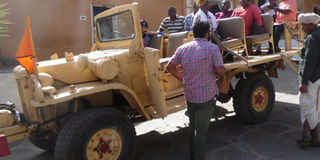India, a country of many contradictions

What you need to know:
From the narrow streets of the ancient town of Rajasamand to the wide multiple lanes of New Delhi, the barefooted women in Vijaypura to the swanky Bollywood stars, the country is both a top world economy but still a developing country. India is a country of incredible contradictions, writes Charles Mwanguhya Mpagi.
While the US boasts of attracting the widest number of nationalities to settle as citizens and integrate, India could also turn out to be the country that has exported the biggest number of nationals to the biggest number of countries in the world who have settled in those new homes as citizens.
From its history, size, population to cultures, religion and history, the contradictions in this vast country are stark. To geographers, it is a Sub-Continent while to an admirer, the presence of world heritage sites like man’s greatest symbol of love the Taj Mahal, great temples, a single figure feel is not enough to tell the pulse of this country.
My recent trip to India was a journey of discovery of both new things, a taste of perceptions and long held stereotypes.
Uganda and India share a long and somewhat ugly historical relationship, dating back to the construction of the famous Uganda railway where Indians-derogatively called Coolies were shipped to East Africa as porters for the railway construction to thousands of them being brutally plucked from a life and normalcy they had attained in the 1970s by Idi Amin.
At the invitation of the Commonwealth Human Right’s Initiative (CHRI), a Delhi based Non-Governmental Organisation which among other policy advocacy initiatives has been at the centre of promoting the Right to Information law passed in this country in 2005.
Rich-poor status
The streets of New Delhi, the Indian capital are shared equally between the filthy rich and poor andthey co-exist harmoniously. Rickshaws or autos, the three-wheeler wonder transporters that are as convenient and menacing in equal measure as Kampala’s boda bodas.
They ride side by side with sleek range drives. The two vehicle systems could easily be products off almost the same assembly line, the phenomenal Tata or Mahindra industries.
Delhi has added an electronic version of the auto that contracts or competes closely with the fast expanding modern metro system.
Venturing out in the city
On the day of our arrival colleagues for the 10-day training programme, we were warned not to venture out. Our host, RTI coordinator at CHRI, the amiable Venkantesh Nanyak told us to be careful when going out particularly that evening as the city was expected to be plunged in some form of colour madness as Indians celebrated the day of colours.
“It is a traditional festival to mark the end of winter and welcome summer,” he told us, “they can throw anything at you from muddy water to colours, do not feel offended, it is not done in bad faith.”
He went further to warn we should not even attempt to venture out before 6pm on the following Monday, but hungry to eat some food and test a bit of Delhi, we ventured out almost immediately. Venkatesh also warned that there was still “some element of racism which is unfortunate”.
On the move
As we navigated, the first missile flew from a storeyed building. Fortunately, it missed only spluttering some fluid on our feet, we were afraid to look up fearing another might land. We did not even investigate what had come down.
However, once the festival was out and by half the 10 days, we had blended, of the racial stares and fears of earlier warning we did not notice much, the people seemed sociable and indifferent like any one of us would deal with a stranger.
But the evidence of extreme poverty penetrated ones nostrils down the gut just as the splendour of modern shopping malls and swanky homesteads that define life here.
A trip to the Rajasmand in Rajasthan State revealed the real India. While in Delhi, nearly every car has written at its tail “don’t hoot”, the vehicles that ply more than 600km journey (it took us nine hours on an air conditioned tourist bus), trucks, pickups and buses urge other drivers to hoot. Large buildings house roadside hotels and nearly every small mountain and hill boasts a temple atop.
And the sanitation?
One drives through possibly the world’s capital of mable. Along the same route extreme poverty is evident.
Perhaps no account of an India experience would miss this; in his autobiography, Experiments with the Truth, Mohandas Karamchand Gandhi, the father of Indian independence, who led the struggle for India’s independence noted with some frustration the question of sanitation and hygiene practices. Fresh air is hard to come by even today, several decades after Ghandi passed on.




